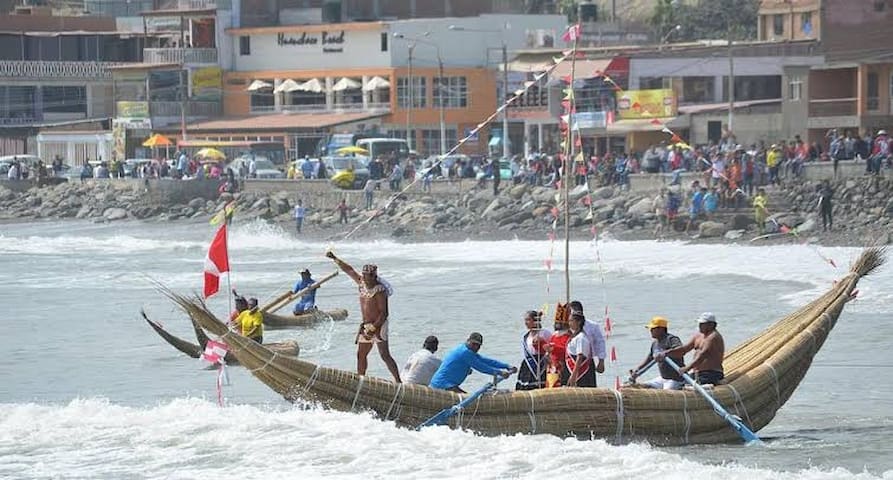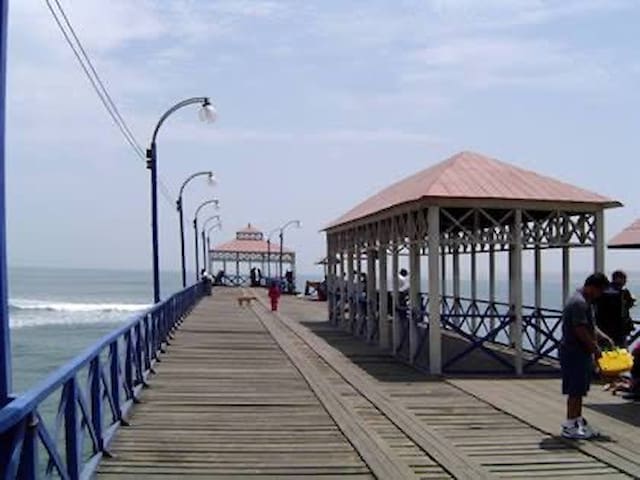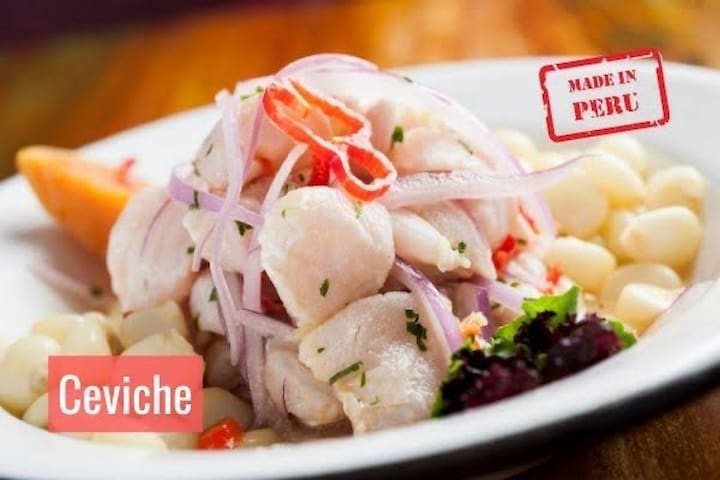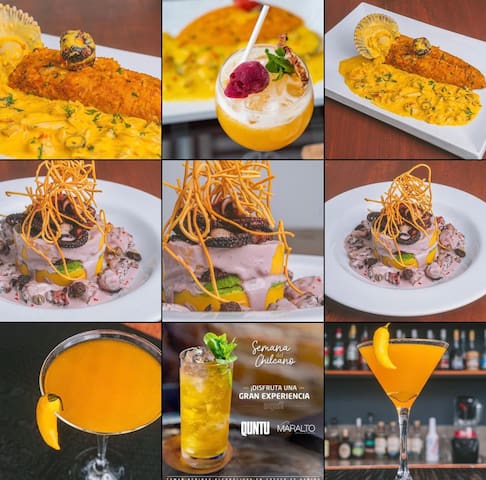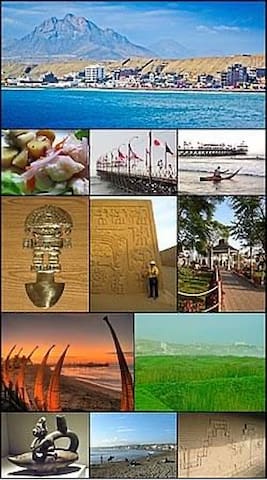Sightseeing
Huanchaco is a popular seaside district in province of Trujillo, Peru and is known for its surf breaks, its caballitos de totora and its ceviche, and is near the ancient ruins of Chan Chan. Huanchaco was approved as a World Surfing Reserve by the organization Save The Waves Coalition in 2012. This historic town is part of the tourist circuit called the "Moche Route" or "Ruta Moche".
49 Einheimische empfehlen
Huanchaco
Huanchaco is a popular seaside district in province of Trujillo, Peru and is known for its surf breaks, its caballitos de totora and its ceviche, and is near the ancient ruins of Chan Chan. Huanchaco was approved as a World Surfing Reserve by the organization Save The Waves Coalition in 2012. This historic town is part of the tourist circuit called the "Moche Route" or "Ruta Moche".
Esta planta acuática es empleada por los pescadores del norte de Perú para confeccionar sus embarcaciones, denominadas "caballitos de totora" por la peculiar forma en que las personas se montan en ellas, semejante a la de un jinete, para efectuar sus maniobras al pescar.
Caballito de Totora Huanchaco Peru
149 La Libertad 726Esta planta acuática es empleada por los pescadores del norte de Perú para confeccionar sus embarcaciones, denominadas "caballitos de totora" por la peculiar forma en que las personas se montan en ellas, semejante a la de un jinete, para efectuar sus maniobras al pescar.
Chan Chan is a pre-Colombian city and archaeological site about 7.7 km from Huanchaco on northern Peru's desert coast. It was the seat of the ancient Chimú civilization before it fell to the Incas. The vast adobe complex has citadels, including the partially restored Tschudi Palace. It also encompasses temples, plazas and cemeteries. The Museo de Sitio Chan Chan displays stone artifacts, ceramics and history exhibits.
54 Einheimische empfehlen
Chan Chan
Chan Chan is a pre-Colombian city and archaeological site about 7.7 km from Huanchaco on northern Peru's desert coast. It was the seat of the ancient Chimú civilization before it fell to the Incas. The vast adobe complex has citadels, including the partially restored Tschudi Palace. It also encompasses temples, plazas and cemeteries. The Museo de Sitio Chan Chan displays stone artifacts, ceramics and history exhibits.
La Iglesia de Huanchaco es considerada como el primer Santuario Mariano en Latinoamérica, y la segunda iglesia construída en el Perú.
El 2 de Febrero de 1537, llego a Huanchaco la imagen de Nuestra Señora de la Candelaria que fue solicitada por el Fray Alonso de Escarcena y fue enviada por la corona Española. Salió de España en el 31 de Enero de 1537 en una embarcación; y cuenta la historia, que en el trayecto ocurrió una terrible tormenta y la tripulación estuvo a punto de naufragar, pero el capitán pidió que sacaran la imagen de la virgen y toda la tripulación se puso a rezar, calmando así la tempestad. Y es por este milagro que desde ese momento se le denómino como Nuestra Señora de la Candelaria del Socorro.
10 Einheimische empfehlen
Iglesia de Huanchaco
La Iglesia de Huanchaco es considerada como el primer Santuario Mariano en Latinoamérica, y la segunda iglesia construída en el Perú.
El 2 de Febrero de 1537, llego a Huanchaco la imagen de Nuestra Señora de la Candelaria que fue solicitada por el Fray Alonso de Escarcena y fue enviada por la corona Española. Salió de España en el 31 de Enero de 1537 en una embarcación; y cuenta la historia, que en el trayecto ocurrió una terrible tormenta y la tripulación estuvo a punto de naufragar, pero el capitán pidió que sacaran la imagen de la virgen y toda la tripulación se puso a rezar, calmando así la tempestad. Y es por este milagro que desde ese momento se le denómino como Nuestra Señora de la Candelaria del Socorro.
In 2012 Huanchaco obtained approval as a World Surfing Reserve by the organization Save The Waves Coalition. This designation is the first awarded to a Latin America town and the fifth in the world. Huanchaco is notable not only for consistent, smooth waves, but also for being the birthplace of the Caballito de totora boat which is regarded as one of the first known surf crafts.Huanchaco's beaches offer smooth and consistent waves, as it is very exposed to all swells.
The Huanchaco Longboard World Championships is a surfing competition that has taken place since 2010 at the El Elio Beach in Huanchaco, and brings together leading surfers of several countries of the world
Surf Peru Beaches
553 Los PinosIn 2012 Huanchaco obtained approval as a World Surfing Reserve by the organization Save The Waves Coalition. This designation is the first awarded to a Latin America town and the fifth in the world. Huanchaco is notable not only for consistent, smooth waves, but also for being the birthplace of the Caballito de totora boat which is regarded as one of the first known surf crafts.Huanchaco's beaches offer smooth and consistent waves, as it is very exposed to all swells.
The Huanchaco Longboard World Championships is a surfing competition that has taken place since 2010 at the El Elio Beach in Huanchaco, and brings together leading surfers of several countries of the world
Muelle de Huanchaco
Punto obligado para quien visite Huanchaco es su muelle. Fue construido hace 125 años, tiene 110 metros de largo y permite una mirada espectacular de toda la playa. Desde allí también se puede practicar la pesca.
Muelle de Huanchaco
Restaurantes
Highly recommend
Big Ben Huanchaco
1184 Avenida Victor Larco HerreraGood food good vies nice restaurant and good service
SunKella
199 Av la RiberaMuchik Experience
387 Avenida Victor Larco HerreraComida deliciosa pero un poco cara
The Lighthouse Restaurant
Jirón ColónMaralto
198 Avenida la RiberaHistory of Huanchaco
Huanchaco's original population were indigenous fishermen, who worshipped the moon and a golden fish called Huaca Taska. Some accounts suggest the name "Huanchaco" originate from "Gua-Kocha, a Quechua word meaning "beautiful lake". During the period of the Chimú culture, 800 to 1400, Huanchaco was the port for Chan Chan, which was established 4 km away. It was also the main port during Moche period, and was described by Inca Garcilaso de la Vega as the preferred port of the Incas.
Huanchaco
Tipps für Reisende
Bräuche und Kultur
COLONIAL ERA
Following the Spanish conquest of 1534, the Spanish town was founded as "Huanchaco" on January 1, 1535 by the Franciscan friar Alonso of Escarcena and Juan de Barbaran.
Subsequently, Huanchaco functioned as the main port of Trujillo city, but the port closed in 1870. Two decades later Victor Larco Herrera rebuilt the pier exclusively for exporting sugar from businesses in the neighbouring Chicama valley, one of the most important areas of sugar production in the country.

